Rome wasn’t built in a day. It took about 800 years to build the city to its peak.
The point? Anything worth building takes time, especially if you want it to stand out.
If it feels like it’s been 800 years since you’ve seen qualified traffic on your site, you’re in the right place.
The four pillars of SEO we’ve compiled here are crucial to any strong online presence. By focusing on these key components, you can transform your site from ancient history into a marvel of leads and conversions.
So, if you want to see if “build it and they will come” still holds true, read on. We’ll discuss how the pillars of SEO can help your site stand out and rank at its peak:
- Technical SEO
- On-page SEO
- Off-page SEO
- Content SEO
By mastering these four pillars, you’ll be well on your way to building a strong online presence.

QUICK REVIEW OF SEARCH ENGINE OPTIMIZATION (SEO)
What is SEO? Search engine optimization (SEO) aims to help websites establish themselves as credible and reliable so that they’ll rank well in search engine result pages (SERPs). The better a webpage ranks, the more traffic it will generate – and more clicks means more leads.
Just like the reputation of a person or a business, SEO is not a single feature or quality. It’s more like a collection of different aspects of a website that come together to form a complete picture of what that site represents and why the search engine should send people there. There are a lot of techniques and knowledge that go into crafting a well-performing site.
At Firestarter SEO, our approach is drawn from experience with hundreds of sites, learning from each one how not just to drive traffic to a site, but to make that traffic uniquely qualified to benefit from what that site offers.
With most online leads generated through organic search results – results that aren’t sponsored – it’s safe to say the benefits of SEO far outweigh its costs.
While SEO is multi-faceted and can be complicated, focusing on the key pillars of SEO can make meaningful improvements, rather than chasing every shiny, ‘quick-fix’ lead-generating solution that comes along.
The “four pillars of SEO” we are about to dig into create a strong foundation for businesses to build upon. These main ideas target optimization from various angles (including the less obvious ones) to ensure that every aspect of a site is set up for success. Let’s take a closer look.

SEO PILLAR #1: TECHNICAL SEO
Think of technical SEO as the “map view” of your website: it focuses on information that helps search engines understand what they can find on your website. Technical SEO involves optimizing a website’s structure and settings to improve user navigation and access to its content.
If you’ve ever gotten a “404” error page when trying to get to a webpage, you know it’s not a good look for any site’s reputation.
Effective technical SEO ensures search engines can “read” your webpage, locate it, and understand how it relates to search inquiries.
Often something is slowing down your site and you probably aren’t even aware that it’s happening unless you are using a tool to monitor and fix errors as they pop up. Which if you are, makes you an incredible site owner and we’re pretty sure there’s an award somewhere with your name on it.
But just in case that’s not quite you yet, we’ve got you.
As we work through a site audit, we use our audit tool to identify and resolve errors starting with critical, working through regular errors, and eventually whittling our way down to “warnings”.
Examples of Technical SEO Pitfalls:
- Not-Found Errors (404 and 500 Errors):
- 404 Error: Occurs when a webpage cannot be found. It results in a poor user experience and can lead to a drop in search engine rankings because users and search engines can’t find the content they were expecting.
- 500 Error: Indicates a server issue preventing the webpage from loading. This can affect the entire site’s performance and credibility.
- Broken Links: Links that lead to non-existent pages, also known as broken links, create a poor user experience and can negatively impact SEO. A broken link usually results in a 404 error, but not all 404 errors are due to broken links. Search engines may view a site with many broken links as poorly maintained and unreliable.
- Duplicate Title Tags: Titles are a critical part of SEO as they inform search engines about the content of a page. Having duplicate titles across multiple pages can confuse search engines and dilute the effectiveness of SEO efforts. Each page must have a unique, descriptive title that accurately reflects its content to improve visibility and rankings.
- Duplicate Content: Having identical or very similar content on multiple pages of your site, or across different sites. This confusion can harm your site’s ranking as search engines may not know which version to index and display in search results, causing both pieces of content to lose ranking.
Technical SEO is a pillar of SEO that the other pillars rely on to thrive. Making your site easy for search engines to navigate, read, and travel you’ll be set up for the search engine to send organic traffic and high rankings your way.
TECHNICAL SEO TIPS & TRICKS
Below are some ways to enhance your technical SEO and make your site a better fit for SERPs:
- Fix Broken Links: We often see where websites have changed URLs and simply didn’t implement the proper 301 redirects. By introducing a redirect, these errors are easily fixed and improve technical SEO and the user experience.
- Build-Up Thin Content: Improving thin content makes a HUGE difference in how the content is viewed by the search engine. Adding detailed information, and building out thin blogs/content on your site you will have much better results.
- Remove Duplicate Content: By using canonical tags you indicate the preferred version of a webpage, which makes it clear the hierarchy of the pages on your site. Efforts to delete or rewrite duplicate content typically result in improved performance for your desired pages.
- Make Your Site Crawlable: One of the most critical issues we see with technical SEO is that websites will have something in place that keeps it from being crawled by the Google crawler. To ensure your site is crawlable, make sure your robots.txt file is correctly configured to allow search engines to access your pages. Additionally, use tools like Google Search Console to identify and fix any crawl errors.
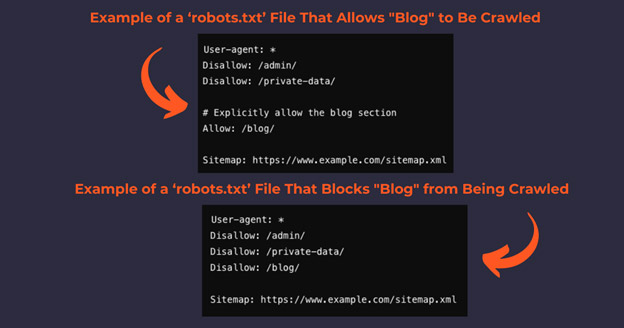
- Create Flat Website Architecture: Structure your website to be wide, not deep. In other words, from your homepage, all the other pages should be easily accessible. This is beneficial for both visitors to your site and most importantly the crawler. Create a sitemap that clearly outlines all the pages on your website and their hierarchical relationship to each other. This sitemap should be submitted to search engines to ensure efficient crawling and indexing of your site.
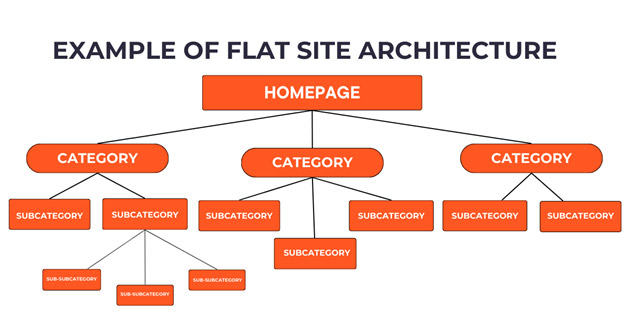
Prioritizing the above tips will make the fastest but most impactful difference to your site performance without getting into the weeds of clearing every error or warning you see.
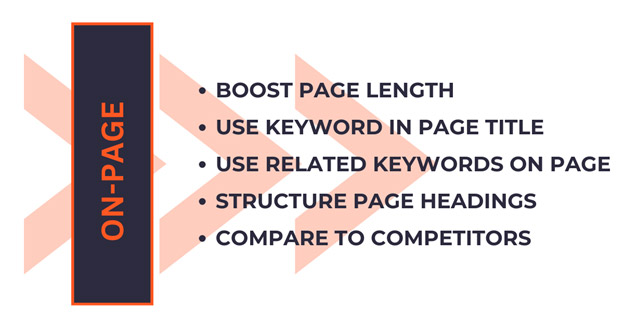
SEO PILLAR #2: ON-PAGE SEO
On-page SEO focuses on the words directly on the pages of your site. The overarching goal is to ensure the page is easily readable and understood by search engines. If Technical SEO is the “map view” of our website, then On-page SEO is the individual roads, locations, and landmarks. Just like on a map, each element should be easily identifiable.
Examples of Elements On-Page SEO Focuses On Include:
- Length of the Page: To stay competitive, you need to know the average word count of the pages currently ranking for your keyword. Then, make an effort to beef up your word count with valuable content. We find that strategic FAQs often add words to the page and serve as an added value to the reader.
- Keyword/ LSI Keyword usage: Using your primary keyword and related keywords on a page significantly impacts its rankings. This strategy improves search results by aligning with the search intent of users. Additionally, the placement of keywords is crucial; positioning them strategically higher on the page, rather than buried in the footer, enhances the page’s relevance and visibility. Comparing the number of uses of the keyword versus your competitors will give you an idea of how many times you need to use it on your page to rank. This is different than keyword density, it’s a direct comparison, averaging keyword usage among competitors and aligning your page with that range.
- Page Titles or Headings: Making sure your keyword and related keywords appear in the H1 heading (Page Title) sets your page up for success. Don’t be misled by the text size on the page; inspect your headings to confirm they are correctly coded. When you keep headings in an order that makes sense it helps establish a clear page structure and highlights the importance of keywords, improving your page’s relevance and visibility. Avoid overusing headings or adding them for arbitrary words; section your page logically to maintain relevance and readability, enhancing both user experience and SEO performance.
On-page optimization is one of the key pillars to improve SEO because it helps search engines see your site as complete, informative, and organized. As a result, your site is seen as valuable and is more likely to outrank the competition.
TIPS FOR ON-PAGE SEO
While this facet of SEO might seem more straightforward, it requires careful attention. By following these steps, you’ll gain confidence in your progress and motivation to continue refining your strategies.
- Evaluate Page Length: Determine the average word count of pages currently ranking for your keyword. Increase your page’s word count with valuable content. For an easy and valuable way to boost word count and provide extra value add an FAQ section.
- Use Your Keyword and LSI: Use your primary keyword and related keywords as well as natural speech synonyms throughout your page. Check the position of your keyword and make sure it’s higher on the page rather than in the footer to enhance relevance and visibility.
- Page Titles and Headings: Include your keyword in the H1 heading (Page Title). Use headings to place keywords and location-based search terms. Remove overused heading tags and logically section your page to maintain relevance and readability.
By following these steps, you’ll enhance your Technical SEO and streamline your page’s structure and content. This foundation improves your site’s SEO performance and prepares it for future optimization efforts.
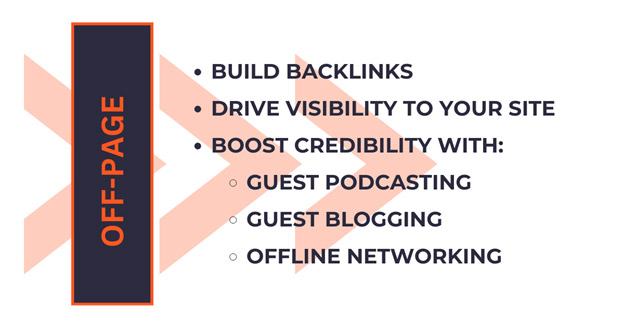
SEO PILLAR #3: OFF-PAGE SEO
Not all SEO work is done on your actual website – some of the most valuable efforts happen behind the scenes.
What do we mean?
Off-page SEO, our third pillar, involves activities outside the optimized site that aim to improve its organic ranking.
Consider your overall marketing strategy as the landmarks on a map, making the destination appealing. Off-page SEO includes the “side projects” that are essential to complete the main goal.
Types of Off-Page SEO That Drive Results:
- Link Building: This involves evaluating your site’s existing links, comparing them with competitors, and aiming for both quality backlinks and a good amount of them to improve search rankings. High-quality links often come from guest posts and industry publications. We put a high value on link-building at Firestarter SEO because we’ve seen how time and again it makes a HUGE difference for our clients.
- Guest Posting: Effective for acquiring quality backlinks and increasing referral traffic, guest posting involves creating valuable content for external websites, which can enhance your site’s visibility and authority.
- Guest Podcasting: Similar to guest posting, guest podcasting allows you to reach new audiences by appearing as a guest on industry-relevant podcasts. This strategy not only helps in gaining backlinks when the podcast episode is shared but also boosts your brand’s authority and visibility in your industry.
- Social Media Marketing: Combining your social media efforts with your SEO strategy can significantly boost your brand’s visibility. This strategy not only increases direct engagement but also enhances SEO efforts as engaging content is more likely to be shared and linked to, expanding your digital footprint organically.
Out of all the pillars of SEO, this one is arguably the most important. Off-page SEO shows a search engine crawler your site has a relative amount of authority and value.
Trusted sites rank higher and drive more leads. Although off-page SEO doesn’t directly affect your site, it builds essential context that makes your brand recognizable.
IDEAS FOR EFFECTIVE OFF-PAGE SEO
To make sure your off-page SEO works as intended, keep the below tips in mind and create a clear strategy that focuses on specific goals.
- Guest Blogging: Identify and collaborate with blogs that align with your industry. Writing guest posts can increase your visibility and establish your authority in your field.
- Giving Interviews: Participate in interviews and podcasts relevant to your niche. This can broaden your audience and drive traffic back to your site.
- Strategic Backlink Building: Make sure your off-page efforts are rewarded with a quality link back to your site. It doesn’t have to be an exact match anchor text either, having links that use a variety of anchor text and even naked URLs (these are URLs that have the URL as the anchor text) can help new and existing pages get a boost in rankings and be indexed on your site.
- Visibility and Engagement: Working hard on off-page SEO and have a great podcast interview to share? Post about it! By promoting these pieces through social media, you drive organic traffic AND showcase your authority.
These strategic off-page SEO tactics do more than promote your site; they elevate its authority, build strategic partnerships, and create a well-rounded SEO campaign.
Let’s explore how compelling content can transform your SEO efforts into a powerhouse of visibility, engaging, informing, and converting your visitors.

SEO PILLAR #4: CONTENT
At Firestarter SEO, we believe that the principle of SEO has always been to create quality content that provides value to the reader. So, our four crucial pillars of SEO wouldn’t be complete without talking about content. We aren’t just talking about words slapped on a page and published on your site. We are talking about creating high-quality and useful content that your target audience values. Valuable information is shareable information, and more sharing means more exposure and backlinks (links to your site from others).
In addition to this, search engines prefer to rank content-rich sites, so by adding quality content you give your site long-lasting value to a site that can’t be replicated.
Your content becomes the voice of your brand and makes you the authority in your niche.
The most important way your site can showcase your expertise is by creating standalone content that supports your keywords.
Good SEO Content Strategies Include:
- Authority Articles: We aren’t just talking about blogs that are 300 words and simply exist on your site. Blogs have become somewhat superficial in the content creation space. With the emergence of AI, and the tendency to keep blogs short and surface they often aren’t the value-packed articles we want to see as part of our “Pillar Content” strategy. Although blogging is a way to put that authority on your site, make sure that the blogs you publish are value-packed and have been crafted by a knowledgeable writer with authority.
- Removing “Fluff” Content: Instead of maintaining 100 small blogs on loosely related topics, focus on what you want to be known for and delete the rest. While there may be topics you personally care about, if no one else does, they won’t generate traffic and will detract from your other content efforts.
- Build Content Clusters: By building related content that supports your pillar page, you can create a web of valuable internal links that makes the main content skyrocket in rankings. This main content could be a homepage and is linked with your keyword as your anchor text.
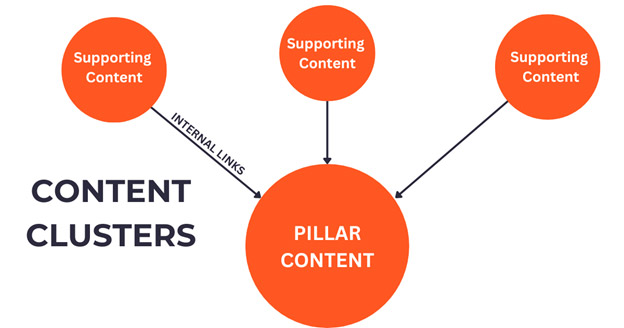
A site that’s been well-organized, readable, and established as credible with the help of other SEO pillars still has little to offer without good content.
After all, the internet is a hub for information – meaningful content shows that your site is worth staying on. Users who spend more time on your site are likelier to engage with your content and use your services because they see you as an authority on the topic they’re interested in.
CREATING CONTENT FOR SEO
Content creation is nuanced, but some key principles can help you succeed. These SEO content pillars ensure your efforts make sense for your goals and produce real results.
Write Pillar Content: Your site should have 2-3 pieces of in-depth content that have topically relevant keywords (or your main keywords). This content should be at least 2,000 words and include headlines that contain your keywords.
Link Pillar Content to “Money-Pages”: We affectionately call transactional pages on a website a “money page” because it is the page you want people to convert on. Simply put, it’s the page that gives you the outcome you want when people visit your website.
Quality vs Quantity: Search engines and readers can distinguish between superficial content and genuinely helpful material. And as AI becomes more and more widely used, genuine and well-crafted content will stand out. For content that ranks well over time, conduct thorough research, and write in a way that resonates with your audience and includes valuable information.
Attract, Engage, and Entertain: None of us are going to turn off Netflix and start binging on books about tax law, and there’s a good reason for that: people are drawn to content that is engaging, accessible, and relevant to their interests (no offense to whoever writes those tax law books). To capture and retain your audience’s attention, ensure your content aligns with their preferences by being readable, engaging, and even entertaining.
READY TO IGNITE YOUR SEO STRATEGY?
Remember, like Rome, building a strong SEO foundation takes time and dedication. By focusing on the four pillars of SEO—technical, on-page, off-page, and content—you can transform your website into a powerhouse of leads and conversions.
At Firestarter SEO, we know the value of a robust SEO strategy. With over 12 years of experience, we’ve crafted tailored SEO solutions for a diverse range of clients. As an award-winning Denver SEO company, we have the expertise to make your business not just get to the top of the search results, but bring with it the qualified leads that ultimately build your business.Contact us today to learn how we can help you build a powerful online presence and achieve lasting success.


